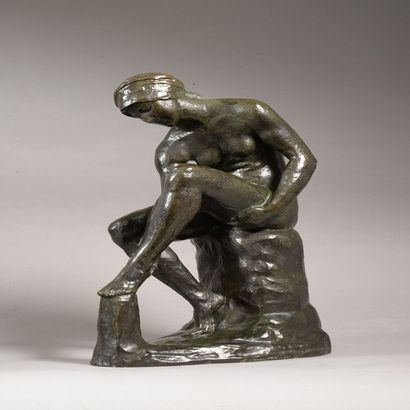Robert Wlerick, estimation et cote
If you own a similar sculpture by Robert Wlerick, or an animal sculpture by a 19th century animal artist, our experts are at your disposal to provide you with a free online estimate of your statue. We can also advise you on any sale process, whether it is an auction or a private sale. Our experts also intervene within the framework of sharing, succession or insurance.
LOT n°69
Robert WLÉRICK
Robert WLÉRICK (1882-1944) - Bather with turban - Bronze with brown patina - Old proof signed "R.W. Wlérick", mark of "F. Barbedienne Fondeur Paris", stamped "Bronze" - Printed before 1944. 42,4...
|
Who was Robert Wlerick ?
Born in Mont-de-Marsan in 1882, Wlerick was the son of a cabinetmaker. Between 1899 and 1904, he studied at the Ecole des Beaux-Arts in Toulouse, but he was dissatisfied with the traditional teaching he received. Wlérick left for Paris in 1906, where he contacted an old friend also from Mont-de-Marsan, the sculptor Charles Despiau, who had worked as one of Auguste Rodin's assistants from 1907 to 1914. Through Despiau, Wlérick met the school of figurative sculptors that was emerging at that time, in opposition to Rodin: Lucien Schnegg, Henry Arnold, Léon Drivier and Jane Poupelet. While Rodin emphasized drama, movement and symbolism, these sculptors returned to classical sculpture, devoid of incidental detail or narrative impetus.
In 1907, Wlérick exhibited for the first time at the Salon de la Société Nationale des Beaux-Arts. In 1908, he took a studio on rue Dutot in Montparnasse, near the studios of Schnegg and Poupelet. In 1912, he sculpted La Petite Landaise, which earned him the praise of Rodin and great success. Wlérick was a figurative artist who modeled the human form and was primarily interested in formal qualities such as balance and harmony. His modeling technique was sensitive and subtle, depicting the life and movement of his subject. His works were modeled in clay over many working sessions, sometimes for several years. He said, "I consider a work of art not a copy but an interpretation and it is never close enough or far enough from nature. All the elements that make up the work must always be taken from nature, but they must be brought together, simplified, emphasized, to create a harmonious whole that remains alive."
From 1922 to 1943, Wlérick taught at the Ecole des Arts Appliqués à l'Industrie in Paris and from 1929, he succeeded Emile-Antoine Bourdelle as professor at the Académie de la Grande Chaumière. He became a Chevalier de la Légion d'honneur in 1926. His work is represented in many major French museums, including the National Museum of Modern Art and the Museum of Modern Art of the City of Paris. A museum in Mont-de-Marsan, in the south of France, is largely devoted to the work of Wlérick and Despiau. Translated with www.DeepL.com/Translator (free version)



